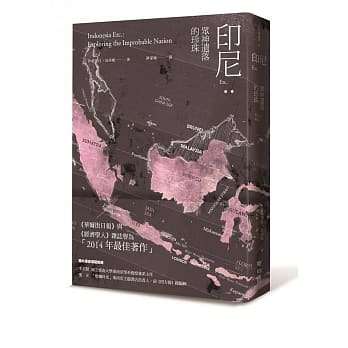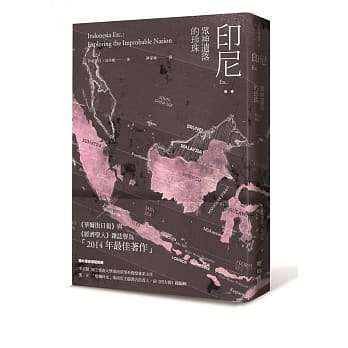Indonesia etc.: Pearls Lost by the Gods
Indonesia etc.: Pearls Lost by the Gods
In stock
Couldn't load pickup availability
出版社: 联经
ISBN/EAN: 9789570845723
出版日期: 2015-06-05
页数: 432页
语言: Traditional Chinese
Do you know Indonesia? How much do you know about the real Indonesia?
Indonesia is the world's largest archipelago, home to one in every 30 people on Earth. Its abundant natural resources have drawn international attention, yet it has long suffered from colonial exploitation and the ravages of conflict and war. Step into this incredible nation of thousands of islands and journey across its more than 13,000 islands to uncover its mysteries and diverse landscapes...
"Best Books of 2014" by The Wall Street Journal and The Economist
Highly recommended by Li Meixian (Professor and Head of the Department of Southeast Asian Studies at National Chi Nan University) and Zhang Zheng (Director of the Southeast Asian-themed bookstore "Brilliant Times" and former Editor-in-Chief of the "Four-Party Newspaper")
Indonesia's 1945 Declaration of Independence promised: "The transfer of power and other matters will be resolved as expeditiously as possible." Seventy years later, the world's fourth-most populous nation is still addressing these "other matters," enthusiastically embracing democracy and striving for pluralistic development. While 80 million Indonesians lack electricity, Facebook boasts 64 million users. It is one of the most resource-rich and attractive countries on earth, yet it is also riddled with political corruption and incompetence, leaving much to be rebuilt.
Indonesia, with a population of approximately 250 million, is South Asia's largest economy. From Sumatra in the northwest, bordering Singapore and Malaysia, it stretches nearly 5,000 kilometers eastward, bordering East Timor and Papua New Guinea, and its maritime border reaches as far as northern Australia. This vast territory, stretching thousands of miles, is rich in cultural diversity, with 360 distinct ethnic groups and 719 languages spoken.
Historically, Indonesia has seen both Buddhist and Hindu kingdoms, but the introduction of Islam by Muslim traders has given Indonesia the world's largest Muslim population. The Dutch East India Company's 350-year colonial rule (1596-1942) introduced Christianity to Indonesia. During World War II, the country was also ruled by Japan for three and a half years.
The Chinese have been present in Indonesia for centuries. Zheng He, during his Ming Dynasty voyages, stopped in Semarang, Demak, and Tuban. Large numbers of Chinese began migrating from Fujian and Guangdong in the late 19th century. Today, there are approximately 20 million Chinese Indonesians, who dominate the Indonesian economy. In the 1960s, during the Suharto administration, a hard-line assimilation policy was implemented against the Chinese, with the Chinese language banned. In May 1998, the economic turmoil triggered by the Asian financial crisis escalated into violent anti-Chinese riots, resulting in the persecution of the Chinese community.
Indonesia's path to independence has been incredibly difficult, as it faces a complex colonial past, a multiracial, multilingual, and multireligious nation. With the resignation of Suharto in 1998, ending 32 years of authoritarian military rule, Indonesia entered a period of democratic reform, lifting many repressive regulations against ethnic Chinese.
Indonesia's September 2014 presidential election was a major event that garnered worldwide attention. The arrival of new President Joko Widodo (Jokowi) in power reshaped South Asia's largest democracy, placing it in a new light compared to Myanmar, Laos, Cambodia, Vietnam, and Thailand. Jokowi also demonstrated strong ambition, proposing a five-year end to the export of domestic workers, universal health insurance, twelve years of compulsory education, a welfare-based family savings program, and simplified investment procedures by 2019, all in the name of building a maritime power.
How much do we know about this rising South Asian power?
Fluent in Indonesian, the author, Pisani, served as a special correspondent for Reuters in Indonesia 25 years ago and returned 10 years later as a medical researcher for the World Health Organization. In 2011, she revisited Indonesia, traveling from its largest cities to its most remote villages. She discovered not only the boundless charm of Indonesia but also the interconnectedness of this diverse nation. She traveled for over a year, exploring the archipelago by motorcycle, bus, and ferry, even taking risks to explore dead ends, alleyways, and neighborhoods unknown to most Indonesians. This journey is a true exploration of the country and its evolving landscape after decentralization. Pisani traveled 20,000 kilometers, visiting local dignitaries and staying with farmers, fishermen, herders, and nurses, often on tiny, uncharted islands. She observed the actual living conditions of the Indonesian people, not only visiting forgotten areas in person, but also integrating into the lives of local indigenous people and participating in their traditional rituals. In a humorous and interesting style, she describes the various unique cultures of this diverse island country.
Since the 1997 financial crisis, which led to the ouster of Suharto, the authoritarian strongman who had ruled for three decades, and the passage of the Local Autonomy Act in 1999, which began implementation in 2001, Indonesia has officially entered a new era of decentralized autonomy. Provinces and regions have since enjoyed unprecedented budgetary and administrative autonomy. In recent years, Indonesia has garnered international media attention as a BRICS nation, brimming with development opportunities and promise, making it a must-see investment destination. Indonesia boasts a youth population of 110 million under the age of 25. What is this coveted young workforce doing? Pisani presents readers with numerous vivid images in this book, but there are no simple answers. She observes that with the progress of democratization, the decentralization of political power has become increasingly evident. Local languages are being reaffirmed, and the traditional cultures of various ethnic groups are being rediscovered.
Indonesia Etc.: The Lost Pearls of the Gods consists of a preface, conclusion, and chapters 1-13. Pisani weaves together her observations and experiences, delving deeply into Indonesia's recent history, corrupt political systems, ethnic and religious identities, rigid bureaucracy, and traditional, sticky culture. Bold and humorous, she uses her meticulous observations and vivid writing to paint a captivating picture of a country.
Elizabeth Pisani
He is fluent in multiple languages (including Indonesian) and holds degrees in classical Chinese, medical demography, and infectious epidemiology. From 1988 to 1991, he served as a special correspondent for Reuters and The Economist in Indonesia. From 2001 to 2005, he worked as an epidemiologist with the Indonesian Ministry of Health. From 2011 to 2012, he traveled to the Indonesian archipelago. He currently lives in London and is the author of The Wisdom of Whores: Bureaucrats, Brothels and the Business of Aids.
Tan Jiayu
A freelance translator, he has translated dozens of books on various topics, including "TOMS Shoes: Wear a pair of shoes and change the world", "China quietly takes over the world", "Forge ahead: How I saved Starbucks" and so on.
Recommendation 1: "Model Student" and Her "Bad Boyfriend" / Li Meixian Recommendation 2: Using Indonesia as a Method / Zhang Zheng
Preface: Indonesia, My Charming Bad Boyfriend Chapter 1: An Incredible Country Chapter 2: Diversity and Unity Chapter 3: Sticky Traditional Culture Chapter 4: Residents from Other Lands Chapter 5: The Emperor is Far Away Chapter 6: A Happy Family Chapter 7: Mother Earth's Favored Child Chapter 8: Profits on Ice Chapter 9: A Page of History Chapter 10: Sumatra's Other World Chapter 11: Ethnic Conflict and Mob Justice Chapter 12: Your Allah, My God Chapter 13: Javanese Silhouette Conclusion: Indonesian Spirituality Sources and Further Reading
Share


